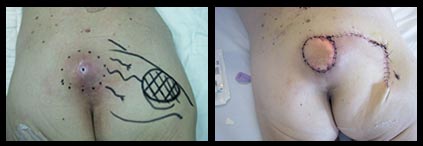
Soft tissue reconstruction
 |
| Sacral decubitus lesions. |
| Please notice the island-shaped marks of the musculocutaneous flap to be used for reconstruction |
The healing process of a skin lesion is very important for a good repairing of any damage the body might have suffered. It is a very common process that all of us have experienced on ourselves. Many are the factors that may influence its outcome. Much depends on the kind of lesion we start with, on the damaging agent and on the involved tissue's specific characteristics. The site of trauma is also important. There are parts of the body that tend to heal more easily and others that take longer and result into more evident signs. Among all specialists, the reconstructive plastic surgeon is certainly the one that has the wider experience in this field. He/she is therefore the most suitable to give advice on the kind of repairing technique to be chosen. Scars are the outcome of the repairing process and are permanent signs. They can improve with time but they will never disappear. Any surgical procedure aimed at improving the quality of the scar is never meant to cancel it completely, but only to make it less visible. An ugly and evident sign is thus substituted with a more acceptable one. The appearance of a scar can be improved to make it less obvious, less noticeable and easier to be camouflaged by means of make up, but a sign will always remain.
The success of a corrective surgical procedure depends on various factors:
- lesion site
- lesion size
- tissue contamination
- connection with secreting areas
- patient's general conditions
- time span between the accident and the beginning of the surgical therapy.
Surgical Techniques
All surgical techniques described in plastic surgery can be employed. Generally one tends to make use of the simplest procedure, the one that is expected to bring the least number of complications. Direct wound closure is the easiest. Follow little skin flap rotation, closure by means of dermo-epidermal grafts or rotation of more complex flaps. In this specific case, it is best to remove the necrotic tissue and cover the flashy area with a rotating skin flap.
Pre and post-operative pictures will be taken. These photographs will be stored in the surgeon's archive and compared with the shots of some time after the operation.
Immediate post-operative period.
The majority of patients undergoing this procedure do not experience pain or discomfort. It is possible, though, that the site of grafting aches a bit and the excoriation produces a quite bearable burning sensation. The treated area is medicated with adhesive tape and protective gauzes that will be changed in the following days.
Risks
There are only minimal risks, which can be compared to those of any other surgical procedure. Every year a number of tissue reparation operations are performed and no major complications are described. On the other hand, it may be that, following an infection or suture margin sufferance, the expected aesthetic improvements are not reached.
